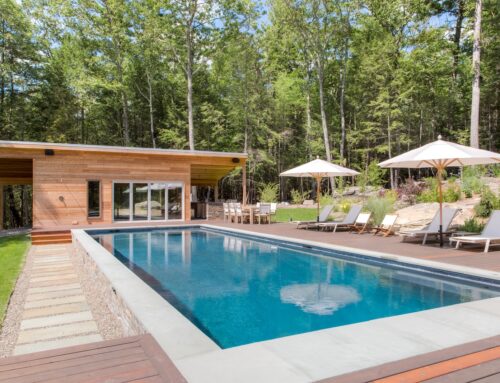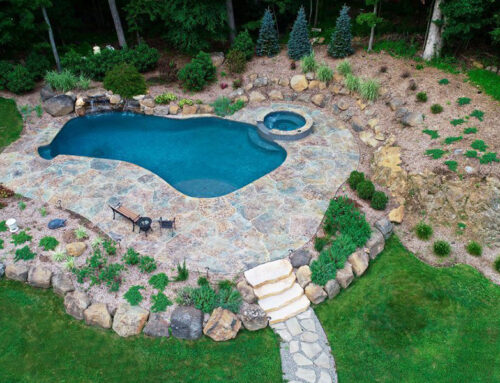No doubt about it — you love your swimming pool. But does your pool love the earth?
Chances are, pool technology has evolved since your pool was installed.
That means there are upgrades and additions available that will not only make your pool more efficient but make it more eco-friendly, too. Let’s take a look at some green, eco-friendly swimming pool options to upgrade your pool:
Variable Speed Pumps
It’s tempting to skimp on your pool pump. After all, a single speed pump will do the job, right? And it’s a couple thousand dollars cheaper than the fancier variable speed model.
A single speed pump is the traditional pool pump, in use for decades. Turn it on, and it runs at a constant speed. It’s the least expensive to buy. But it’s also noisy and inefficient.
It runs on one speed — high — whether high speed is needed or not. That means you’re paying for high speed, even when you don’t really need to.
A much better choice is a variable speed pool pump. You’ll pay between $500 to $600 more. But running a single speed pump will cost you more to operate, and that cost adds up quickly.
A variable speed pump allows the speed to be adjusted to the exact flow rate you need — from off to high, and many speeds in between. A variable speed pump runs quieter, stays cooler and lasts longer. And, most importantly, it uses much less energy.
Some manufacturers claim variable speed pumps because they don’t have to work as hard, will last three times longer than a single speed pump.
Low Voltage, LED Lights
Don’t forget lighting in your pool sustainability plan. LED underwater pool and spa lights are much more energy efficient than traditional incandescent and halogen pool lights.
LED pool lights use just a fraction of the wattage that halogen lights do to create the same amount of light. And LEDs are more durable — lasting up to 10 times longer than the traditional bulbs that might light your pool now.
That goes for the landscape lighting that surrounds your pool, too.
Electric Heat Pumps
Gas pool heaters are the least expensive option up front, so it’s tempting to opt for that. They eliminate the need to have a gas connection which helps offset the unit’s cost. Gas heaters can warm the body of your pool up to three times faster than an electric heat pump — but they also consume up to three times more energy. So while gas heaters are less expensive up front, they cost more over time to operate. Gas heaters are recommended for spas. Electric heat pumps they take too long to heat the water up.
A better bet long term is an electric heat pump, which uses less overall power than a comparable gas heater. The difference is substantial.
The U.S. Department of Energy estimates a gas heater will cost $1,448 a year to heat an outdoor pool in New York at a temperature of 78 degrees. The cost jumps to $1,904 to heat it to 80 degrees and to $2,384 for 82 degrees. This is based on a 1,000 square foot pool, heated from May 1 to September 30.
Use an electric heat pump, and that cost plummets to $740 a year, with all the same factors. The cost jumps to $975 to heat it to 80 degrees and to $1,220 for 82 degrees.
Yes, buying an electric heat pump will cost you $1,000 to $1,500 more up front. But figure in the savings in operation costs and that higher-priced pump will pay for itself in two pool seasons.
Pool Automation
Pool automation has become more and more sophisticated over the years. Not only does it save you time and hassle, but it saves energy, which means it’s better for the environment. We see it happen all the time.
Automated systems can control everything from sanitizing to heating to turning on lights and water features. They’re set to make adjustments when needed to run more efficiently than when you control them manually. If you’re not running your heat pump around the clock, your bill will be lower, much the way a programmable home thermostat saves you money on your energy bill.
It’s common to leave your various pool systems — heating, filters, lighting — on more often than needed. Have you ever cranked up your pool heater, and then forgot to turn it down? Automation systems leave them on only as long as necessary.
Salt Chlorine Generator
The salt chlorine generator used in salt water pools has revolutionized swimming pool care, and it’s good for the environment, too. This pool sanitizing system uses common table salt to produce all the chlorine a pool needs, safely, effectively, and automatically.
Pool owners often add too much chlorine to their pools. With a salt chlorine generator, there are no chlorine tablets, liquid or granules to add. Less chlorine use means less chlorine production. And that means less chemical processing, emissions, and energy use.
Geothermal And Solar Heating
If you’re on the environmental cutting edge and already heat your home with a geothermal heating and cooling system — or your new home plans to include one — it’s easy to hook into your home’s system and heat your pool this way, too.
Geothermal pool heat pumps work together with the stable earth temperatures to provide heating for your pool throughout the swimming season. It’s the most environmentally conscious way to heat your pool.
Not that advanced? There are hybrid versions that involve running pipes underneath your patio to take advantage of solar heating. The sun-baked patio heats the pool, and the water running under the patio cools its surface a bit.
Note this doesn’t provide enough heat to fire up a hot tub, but it definitely takes the chill off your pool water.
Automatic Pool Covers
Pool covers aren’t just for winter. Each day your pool remains uncovered, some of that refreshing water evaporates — poof! Then you have to replace it. That’s just wasteful.
But the big savings is energy. Covers keep the heat in, which means your heater has to work less. Eighty percent of the heat is lost at night. During the day, a pool cover acts as a solar cover creating a greenhouse effect which helps reduce heat loss.
Pool covers are for safety too. They keep unwanted animals out of the pool and reduce the risk of children falling into the pool.
Swimming Pool Filters: Cartridge Vs. Diatomaceous Earth Or Sand
Pool owners tend to have a favorite when it comes to pool filters. Some say sand is the cheapest, so they like that. Others swear diatomaceous earth (DE) makes for the clearest water, so that’s their pick.
If water savings is important to you, a cartridge filter is the most efficient choice. Unlike sand and DE filters, cartridge filters don’t use the backwash method for cleaning, which uses extra water. When it’s time to clean the cartridges, just remove and wash them.
An Eco-Friendly Swimming Pool Starts With Neave
Sustainability is important to us here at Neave Pools. That’s why our experts would love to talk to you about some simple pool upgrades that can make your pool an eco-friendly swimming pool.
If you’re in Hudson Valley, call (845) 463-0592. Westchester, call (914) 271-7996. Cold Spring, call (845) 463-0592, and in Connecticut, call (203) 212-4800. Or fill out the handy web form on this page, and we’ll get in touch with you to schedule a complimentary swimming pool consultation.

























